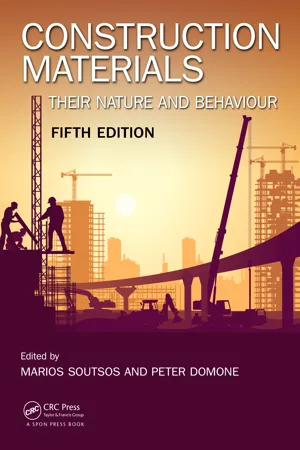
Construction Materials
Their Nature and Behaviour, Fifth Edition
- 820 pages
- English
- ePUB (mobile friendly)
- Available on iOS & Android
Construction Materials
Their Nature and Behaviour, Fifth Edition
About this book
This established textbook provides an understanding of materials' behaviour through knowledge of their chemical and physical structure. It covers the main classes of construction materials: metals, concrete, other ceramics (including bricks and masonry), polymers, fibre composites, bituminous materials, timber, and glass. It provides a clear and comprehensive perspective on the whole range of materials used in modern construction, to form a must-have for civil and structural engineering students, and those on courses such as architecture, surveying and construction.
It begins with a Fundamentals section followed by a section on each of the major groups of materials. In this new edition:
- The section on fibre composites FRP and FRC has been completely restructured and updated.
- Typical questions with answers to any numerical examples are given at the end of each section, as well as an instructor's manual with further questions and answers.
- The links in all parts have also been updated and extended, including links to free reports from The Concrete Centre, as well as other online resources and material suppliers' websites.
- and now with solutions manual and resources for adopting instructors on https://www.crcpress.com/9781498741101
Frequently asked questions
- Essential is ideal for learners and professionals who enjoy exploring a wide range of subjects. Access the Essential Library with 800,000+ trusted titles and best-sellers across business, personal growth, and the humanities. Includes unlimited reading time and Standard Read Aloud voice.
- Complete: Perfect for advanced learners and researchers needing full, unrestricted access. Unlock 1.4M+ books across hundreds of subjects, including academic and specialized titles. The Complete Plan also includes advanced features like Premium Read Aloud and Research Assistant.
Please note we cannot support devices running on iOS 13 and Android 7 or earlier. Learn more about using the app.
Information
Table of contents
- Cover
- Half Title
- Title Page
- Copyright Page
- Contents
- Preface
- Acknowledgements
- Editors
- Part I: Fundamentals
- Part II: Metals and alloys
- Part III: Concrete
- Part IV: Polymers
- Example questions for Part IV Polymers
- Further reading for Part IV Polymers
- Part V: Fibre composites
- Example questions for Part V Composites
- Further reading for Part V Composites
- Part VI: Glass
- Example questions for Part VI Glass
- Further reading for Part VI Glass
- Part VII: Timber
- Example questions for Part VII Timber
- Further reading for Part VII Timber
- Part VIII: Masonry: Brickwork, blockwork and stonework
- Example questions for Part VIII Masonry: Brickwork, blockwork and stonework
- Further reading for Part VIII Masonry: Brickwork, blockwork and stonework
- Part IX: Bituminous materials
- Example questions for Part IX Bituminous materials
- Further reading for Part IX Bituminous materials
- Part X: Selection and sustainable use of construction materials
- Index